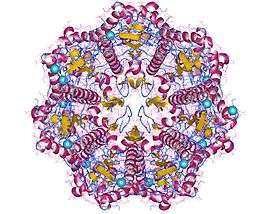Endopeptidase Clp
Endopeptidase Clp (EC 3.4.21.92, endopeptidase Ti, caseinolytic protease, protease Ti, ATP-dependent Clp protease, ClpP, Clp protease).[1][2][3][4] This enzyme catalyses the following chemical reaction
- Hydrolysis of proteins to small peptides in the presence of ATP and Mg2+.
| Endopeptidase Clp | |||||||||
|---|---|---|---|---|---|---|---|---|---|
 ATP-dependent Clp protease (fragment) homo14mer, Streptococcus pneumoniae | |||||||||
| Identifiers | |||||||||
| EC number | 3.4.21.92 | ||||||||
| CAS number | 110910-59-3 | ||||||||
| Databases | |||||||||
| IntEnz | IntEnz view | ||||||||
| BRENDA | BRENDA entry | ||||||||
| ExPASy | NiceZyme view | ||||||||
| KEGG | KEGG entry | ||||||||
| MetaCyc | metabolic pathway | ||||||||
| PRIAM | profile | ||||||||
| PDB structures | RCSB PDB PDBe PDBsum | ||||||||
| |||||||||
This bacterial enzyme contains subunits of two types, ClpP, with peptidase activity, and the protein ClpA, with AAA+ ATPase activity. ClpP and ClpA are not evolutionarily related.
A fully assembled Clp protease complex has a barrel-shaped structure in which two stacked heptameric ring of proteolytic subunits (ClpP or ClpQ) are either sandwiched between two rings or single-caped by one ring of hexameric ATPase-active chaperon subunits (ClpA, ClpC, ClpE, ClpX, ClpY, or others).[5]
ClpXP is presented in almost all bacteria while ClpA is found in the Gram-negative bacteria, ClpC in Gram-Positive bacteria and cyanobacteria. ClpAP, ClpXP and ClpYQ coexist in E. Coli while only ClpXP complex in present in humans as mitochondrial enzymes.[5] ClpYQ is another name for the HslVU complex, a heat shock protein complex thought to resemble the hypothetical ancestor of the proteasome.[6]
ATPase
| ClpA/B | |||||||||
|---|---|---|---|---|---|---|---|---|---|
| Identifiers | |||||||||
| Symbol | ClpA/B | ||||||||
| Pfam | PF02861 | ||||||||
| InterPro | IPR001270 | ||||||||
| |||||||||
| ClpX | |
|---|---|
| Identifiers | |
| Symbol | ClpX |
| InterPro | IPR004487 |
The Hsp100 family of eukaryotic heat shock proteins is homologous to the ATPase-active chaperon subunits found in the Clp complex; as such the entire group is often referred to as the HSP100/Clp family. The family is usually broken into two parts, one being the ClpA/B family with two ATPase domains, and the other being ClpX and friends with only one such domain.[7] ClpA through E is put into the first group along with Hsp78/104, and ClpX and HSIU is put into the second group.[8]
Many of the proteins are not associated with a protease and have functions other than proteolysis. ClpB (human CLPB "Hsp78", yeast Hsp104) break up insoluble protein aggregates in conjunction with DnaK/Hsp70. They are thought to function by threading client proteins through a small 20 Å (2 nm) pore, thereby giving each client protein a second chance to fold.[8][9][10] A member of the ClpA/B family termed ClpV is used in the bacterial T6SS.[11]
See also
- Endopeptidase
- CLP protease family
- ATP-dependent Clp protease proteolytic subunit
References
- Gottesman S, Clark WP, Maurizi MR (May 1990). "The ATP-dependent Clp protease of Escherichia coli. Sequence of clpA and identification of a Clp-specific substrate". The Journal of Biological Chemistry. 265 (14): 7886–93. PMID 2186030.
- Maurizi MR, Clark WP, Katayama Y, Rudikoff S, Pumphrey J, Bowers B, Gottesman S (July 1990). "Sequence and structure of Clp P, the proteolytic component of the ATP-dependent Clp protease of Escherichia coli". The Journal of Biological Chemistry. 265 (21): 12536–45. PMID 2197275.
- Maurizi MR, Thompson MW, Singh SK, Kim SH (1994). "Endopeptidase Clp: ATP-dependent Clp protease from Escherichia coli". Methods in Enzymology. 244: 314–31. doi:10.1016/0076-6879(94)44025-5. PMID 7845217.
- Kessel M, Maurizi MR, Kim B, Kocsis E, Trus BL, Singh SK, Steven AC (July 1995). "Homology in structural organization between E. coli ClpAP protease and the eukaryotic 26 S proteasome". Journal of Molecular Biology. 250 (5): 587–94. doi:10.1006/jmbi.1995.0400. PMID 7623377.
- Hamon, MP; Bulteau, AL; Friguet, B (8 January 2015). "Mitochondrial proteases and protein quality control in ageing and longevity". Ageing Research Reviews. 23 (Pt A): 56–66. doi:10.1016/j.arr.2014.12.010. PMID 25578288.
- Gille C, Goedel A, Schloetelburg C, Preißner R, Kloetzell PM, Gobel UB, Frommell C. (2003). A Comprehensive View on Proteasomal Sequences: Implications for the Evolution of the Proteasome. J Mol Biol 326: 1437–1448.
- Schirmer, Eric C.; Glover, John R.; Singer, Mike A.; Lindquist, Susan (August 1996). "HSP100/Clp proteins: a common mechanism explains diverse functions". Trends in Biochemical Sciences. 21 (8): 289–296. doi:10.1016/S0968-0004(96)10038-4.
- Doyle, Shannon M.; Wickner, Sue (January 2009). "Hsp104 and ClpB: protein disaggregating machines". Trends in Biochemical Sciences. 34 (1): 40–48. doi:10.1016/j.tibs.2008.09.010.
- Horwich AL (November 2004). "Chaperoned protein disaggregation--the ClpB ring uses its central channel". Cell. 119 (5): 579–81. doi:10.1016/j.cell.2004.11.018. PMID 15550237.
- Weibezahn J, Tessarz P, Schlieker C, Zahn R, Maglica Z, Lee S, Zentgraf H, Weber-Ban EU, Dougan DA, Tsai FT, Mogk A, Bukau B (November 2004). "Thermotolerance requires refolding of aggregated proteins by substrate translocation through the central pore of ClpB". Cell. 119 (5): 653–65. doi:10.1016/j.cell.2004.11.027. PMID 15550247.
- Schlieker, C; Zentgraf, H; Dersch, P; Mogk, A (November 2005). "ClpV, a unique Hsp100/Clp member of pathogenic proteobacteria". Biological Chemistry. 386 (11): 1115–27. doi:10.1515/BC.2005.128. PMID 16307477.
External links
- Endopeptidase+Clp at the US National Library of Medicine Medical Subject Headings (MeSH)